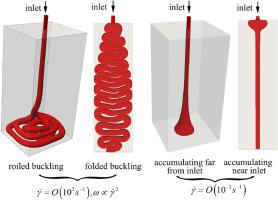International Journal of Mechanical Sciences ( IF 7.1 ) Pub Date : 2021-08-15 , DOI: 10.1016/j.ijmecsci.2021.106742 Shaozhen Hua 1 , Cheng Chang 2 , Huabo Liu 1 , Fanjing Meng 1

|
Jet buckling of high viscous fluid is a common phenomenon both in nature and industry. In order to effectively understand this phenomenon, experiments, numerical simulation and dimensional analysis are employed with the jet buckling of rubber melt and in injection molding. To begin with the construction of two high-resolution discretization schemes for convection terms, a three dimensional algorithm for liquid jet buckling phenomenon is established based on two phase flow model and discretization via finite volume method. The developed algorithm shows its good accuracy and stability for jet buckling simulation. The numerical results are in good agreement with experimental results obtained by camera directly and short shot experiments. It is found shear rate and gravity have an effect on jet buckling. Compared to non-buckling, buckling of liquid occurs at high shear rate. Direction of gravity influences the length of jet and the pattern of buckling. Furthermore, dimensional analysis of buckling is carried out based on experimental and numerical results. Results reveal that the influence of gravity on buckling is greater when gravity is vertical than parallel to velocity. Dimensional analysis illustrates that shear rate has a greater effect on buckling frequency than hydraulic radius of inlet, length of cavity, gravitational force, viscous force and kinematic viscosity. The buckling frequency is approximately proportional to the square of the shear rate.
中文翻译:

高粘性流体射流屈曲的数值与量纲分析
高粘性流体的射流屈曲是自然界和工业中的普遍现象。为了有效地理解这种现象,在橡胶熔体的喷射屈曲和注塑成型中采用了实验、数值模拟和尺寸分析。从构建两种高分辨率对流项离散化方案开始,基于两相流模型和有限体积法离散化,建立了液体射流屈曲现象的三维算法。所开发的算法在射流屈曲模拟中表现出良好的准确性和稳定性。数值结果与相机直接实验和短镜头实验得到的实验结果吻合较好。发现剪切速率和重力对喷射屈曲有影响。与非屈曲相比,液体的屈曲发生在高剪切速率下。重力方向影响射流长度和屈曲模式。此外,屈曲的尺寸分析是基于实验和数值结果进行的。结果表明,当重力垂直于速度时,重力对屈曲的影响更大。量纲分析表明,剪切速率对屈曲频率的影响大于入口水力半径、空腔长度、重力、粘性力和运动粘度。屈曲频率大约与剪切速率的平方成正比。结果表明,当重力垂直于速度时,重力对屈曲的影响更大。量纲分析表明,剪切速率对屈曲频率的影响大于入口水力半径、空腔长度、重力、粘性力和运动粘度。屈曲频率大约与剪切速率的平方成正比。结果表明,当重力垂直于速度时,重力对屈曲的影响更大。量纲分析表明,剪切速率对屈曲频率的影响大于入口水力半径、空腔长度、重力、粘性力和运动粘度。屈曲频率大约与剪切速率的平方成正比。











































 京公网安备 11010802027423号
京公网安备 11010802027423号